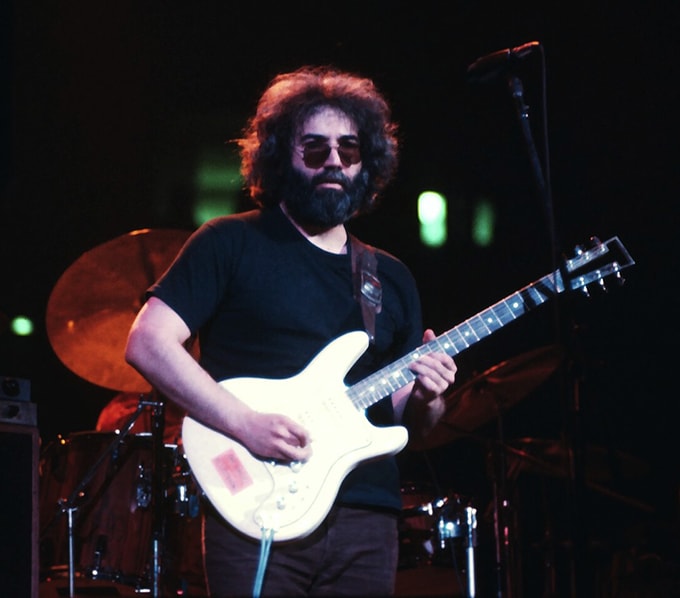I cried a little bit when Jerry Garcia died. I saw the Grateful Dead for the first time in 1967 and was in awe. I became a Deadhead and saw them many more times into the 1970s. Jerry’s stage persona was that of a big teddy bear with frizzed out hair and a warm, gentle demeanor that gave the impression that he was smiling even when he wasn’t.
While Jerry on lead guitar was always the number one attraction for Deadheads, he never tried to steal the show. On stage, Bob Weir handled most of the interactions with the audience. For a number of years, the New Riders of the Purple Sage traveled with the Dead and was their warm-up band. In the beginning of NRPS’s career, Jerry was their pedal steel guitarist, in addition to playing with the Dead. He never tried to upstage the leaders of that group; he was simply their guy on pedal steel. Jerry was also the banjo player in a bluegrass band called Old And In The Way. Again, he didn’t try to be the central attraction. He was the guy on banjo, and a very good one at that.
I saw the Dead several times at New York’s Fillmore East. I recall one midnight concert where we left at 4:30 am and they were coming out for yet another encore. My favorite live Dead song was “Tennessee Jed,” and I remember another Fillmore concert where Jerry had just finished his awesome solo and the band had broken into their chorus of, “Tennessee, Tennessee, there ain’t no place I’d rather be.” I caught the eye of the guy next to me who I didn’t know from a hole in the wall and we nodded at each other. The message was clear. There wasn’t anywhere on this planet where anyone should want to be that night other than the Fillmore East.
I saw the Dead for the last time at an outdoor venue somewhere in Connecticut in the mid-1970s. I was distracted and annoyed by the rumble of Harleys and the presence of a number of people with whom I would never want to strike up a conversation. The crowd had changed. It just wasn’t the same.
I cried a little bit when Rick Danko died. Danko was The Band’s bass player and one of their lead singers. He was an accomplished vocalist with an unmistakable, falsetto-ish style. His most recognizable vocal is probably his verse in “The Weight,” the one that begins with, “Crazy Chester followed me and he caught me in the fog.” His shining moment as a singer was “It Makes No Difference” from The Last Waltz album. That one was all his, an excellent song beautifully sung from the depths of his soul.
I lived in New York’s Hudson Valley in the 1980s and 1990s while working for IBM, and The Band lived a little up-river. I got to see them (without Robbie Robertson, who had left by then) many times. Two of my favorite venues were The Chance, a Poughkeepsie theater, and The Towne Crier, a restaurant then located in Pawling. Sometimes one or another Band member was absent and subbed by an unknown, but Danko would always be there. He also led a group called “Rick Danko and Friends.” I never saw a performer who loved being on stage more than he did.
In 1970, there was a music festival that traveled across Canada by train and included The Band, Janis Joplin, The Grateful Dead, and many others. It is documented in a fine video called Festival Express. One of the highlights of that film is a drunken jam session on the train led by, of course, Rick Danko. He was the personification of that wonderful John Belushi character, The Last Guy at the Party. That’s where the party had ended, everyone else had gone home, the hosts were dying to go to sleep, and there’s Belushi, ready for one more beer.
I cried a little bit when Richie Havens died. In the 1960s, I was a regular at the Cafe Au Go Go in New York’s Greenwich Village where Havens was the house folk singer. I saw him perform many times and engaged with him in a couple of one-on-one conversations. The first happened while smoking cigarettes between acts in front of the Cafe. I recall being fixated on the fact that he had no upper teeth! I have no idea what we spoke about but was flattered that he truly seemed interested in what I was saying and spoke with me, a know-nothing 19-year-old, as a peer. He was a wonderful, gentle, thoughtful man.
I was at Woodstock in 1969 and was thrilled that Havens was selected as the opening act for the festival. He captivated the audience but I was a little disappointed that he didn’t perform my favorite, “San Francisco Bay Blues.” I saw him many more times into the 1990s at various venues in the NY area, the last time at the Towne Crier. I then had a corporate relocation to Austin, Texas and never saw him again.
Many people from my generation still listen mostly to music from “back in the day.” Their tears are surely of loss and sorrow. While I still enjoy the music of the 1960s and 1970s, my music listening is focused on more recent artists who have satisfied my thirst for music all these years. Examples are M. Ward, Tomasz Stanko, and Arcade Fire. Thanks to them, mine are tears of fond remembrances of a magical era in the history of our music.
About Jeff Weiner:
Jeff Weiner is a docent at the MIM Musical Instrument Museum in Phoenix, Arizona. Born in Brooklyn, NY, he was formerly an engineer at IBM, and a mathematics teacher. He attended the Woodstock festival in 1969 and was a regular at the Cafe Au Go Go in the 1960s.
Header image: Jerry Garcia, courtesy of Wikimedia Commons/Carl Lender.



